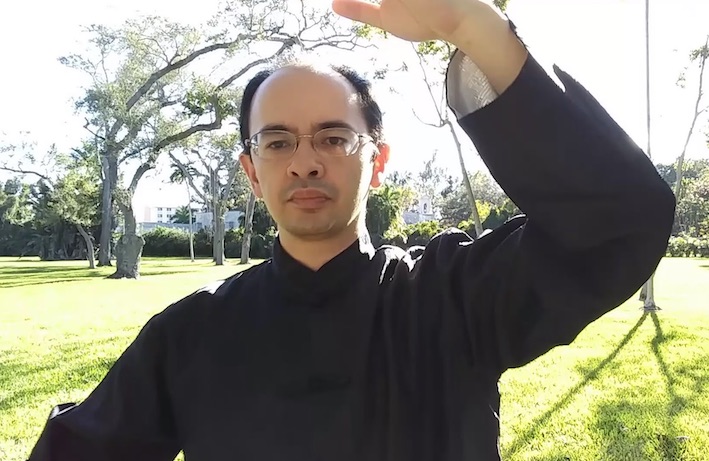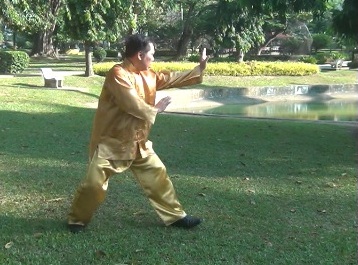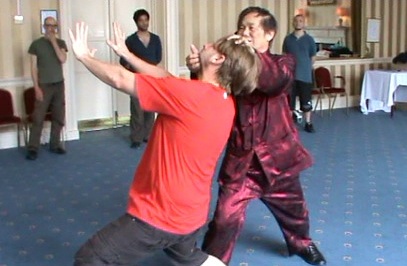SWIMMING DRAGON AND FUTURE OF BAGUAZHANG
Frederick Chu -- Shaolin Wabnam USA

Dr Frederick Chu performing a Baguazhang pattern
38. Swimming Dragon Baguazhang
Tradition holds that the Eight Mother Palms each have eight variations and modifications that give rise to the Sixty Four Palms of Baguazhang combat application [1, 4, 5, 6, 8, 15, 16, 17, 22, 24]. After becoming competent at the Eight Mother Palms, students in Shaolin Wahnam learn more advanced tactics and complicated fighting situations through the practice of the eight sequences that comprise the Swimming Dragon set.
Like all pre-established combinations and choreographies, the onus of a combat sequence set is not that the practitioner will always fight exactly as dictated by their set (although skillful combatants can use a sequence of applications almost regardless of how an opponent responds), but rather to spend time focusing on skills that can be drawn upon without thinking when the combatant finds themselves in an analogous situation. Note also that Swimming Dragon combat sequences tend to be rather long, often involving ten or more exchanges. Most actual fights do not last that long unless combatants are exceedingly well matched with one another.
In the Shaolin Wahnam version of the Swimming Dragon set, half of the combat sequences begin with the combatants apart and half of them begin with the combatants already having their lead forearms in contact. This is to provide opportunities for Baguazhang students to practice safely entering into an opponent to deliver or defend against an attack as well as how to sense and respond to an opponent once contact is already made.
While Baguazhang does not have as deep of a tradition of sensing skills such as Taijiquan Pushing Hands or Wing Chun Sticking Hands, there is much in the way of sensing skills built into typical Baguazhang combat applications [17].
Complete analysis of the entire Swimming Dragon set, which comprises nearly three hundred movements, is beyond the scope of this treatise. However, a brief analysis of the first combat sequence, which highlights many important core principles of Baguazhang combat application, will be discussed here.
The first combat sequence begins with both practitioners, the initiator and responder, evaluating one another while remaining at Green Dragon Tests Claw. The initiator steps in with Open Window Look at Moon, using their front arm as a bridge to make contact with the opponent, test their guard, and open their guard to deliver a palm strike with their rear hand to the opponent's chest. This is a very typical attack in Baguazhang and uses many characteristic principles, such as the simultaneous use of both hands, the Stream Character stance, force issued from a palm strike, and keeping one forearm in reserve to sense the opponent's response.
The responder defends themself in kind, stepping back and deflecting the incoming palm strike with their own forearm before delivering their own palm strike to the initiator's chest using their own Open Window Look at Moon. When you are unsure of your opponent's level of skill or force, it is more advisable to use conservative techniques that have much safety built into them. Again, the presence of a sensing and deflecting hand, the narrow Stream Character stance, and the frontal palm strike at close range provide many opportunities to respond to a surprise counter from an opponent.
From here, things begin to get more interesting. The initiator, upon seeing that their initial attack failed and a counter is coming towards their own head or chest, takes a slight step back with their front foot, threads away the incoming palm with their own previously striking palm, and then steps to the responder's side to deliver a palm strike to the side of the responder's head or body in the pattern Green Dragon Returns Head.
The astute observer will note that the initiator has essentially weaponized the poise pattern used in Circle Walking. In using footwork and attacks to get to an opponent's flanks or side, experience will show that the more committed an opponent is in their attack, the easier it will be to get to the flank or side. In some instances, opponents who overly commit to attacking the space you once occupied will do all the work for you, leaving themselves entirely exposed.
The flanking attack is most characteristic of Baguazhang beginners and intermediate practitioners, followed by experts and masters who circle all the way to an opponent's back because of their superior skill. It is very important for beginners to practice the application of their flanking step. A very worthy drill for Baguazhang students would be to train the transition from Open Window Look at Moon to Green Dragon Returns Head many times everyday as a matter of regular practice, after their Circle Walking and other force training before training anything else.
The responder, not wishing to have their face or body damaged, shifts away from the incoming palm strike before sinking down into the Horse Riding stance and delivers a reverse palm slice to the initiator's groin with Bail Moon From Sea Bottom. Depending on the height of the initiator's attack, the responder's rear guard hand may be used to float up at the initiator's hand or merely be kept near the front shoulder if the responder feels they are adequately far away from the initiator's hand.
This counter reveals an inherent weakness to the sideways stance used in Green Dragon Returns Head, namely that the groin and lower body may be exposed to an opponent who is perpendicular to that sideways stance. Likewise, it demonstrates the principle of using what is heavy and solid (the Horse Riding stance with pressing footwork) against that which is light (the sideways Stream Character stance).
Much kung fu literature discusses using softness when an opponent is hard and vice versa [1, 7, 15, 16, 18, 22, 23], which is a very valid tactic, especially for beginners and intermediate practitioners. Experts and masters, because of their deep skills and wide experience, may use whatever they wish against any situation. All practitioners, regardless of beginners or more seasoned practitioners, must likewise be aware of any inherent weaknesses in their combat.

"Green Dragon Tests Claw" in the Swimming Dragon Set
The initiator deals with the palm slice to their groin by shuffling back in their Stream Character stance to get out of range from the responder's hand and directly sweeps their palm downward at the attacking arm's wrist, forearm, or elbow using Separate Grass Search for Snake. In kung fu parlance, this is known as a direct counter-attack, or no defense direct counter [18, 19].
Rather than brushing aside the incoming Bail Moon From Sea Bottom as a block or deflection, the initiator's safety has already been guaranteed by the spacing provided by their shuffle backwards; if the responder's reach were too great for a shuffle, then the initiator's safety would be acquired from stepping back into a T step or even taking a full step backwards. The initiator's own palm chop is meant to directly attack and damage the responder's arm to prevent them from fighting effectively.
The initiator immediately follows through after Separate Grass Search for Snake by stepping slantingly with their Horse Riding stance behind the responder, guarding and twisting their upper body, covering themselves from a possible counter-attack, and sinking their stance to throw the opponent to the floor using the pattern Black Bear Fells Tree. As all martial artists should know, throwing techniques are not brutal, tight-jawed, sweat-drenched contests of strength. That is for the movies. There is significant set up required for a throw, and the actual sinking of one's stance to bring the opponent to the ground is simply a confirmation of what has gone before.
The responder, not wishing to have their arm broken by Separate Grass Search for Snake or thrown to the ground by Black Bear Fells Tree, withdraws their "bailing" arm and escapes the initiator's throw by simultaneously sweeping their arms outwards in a manner similar to Lone Bird Flies Away and lifting their front leg to remove the initiator's point of leverage and immediately follows with returning their front foot to the ground in a Stream Character stance, using their rear hand to clamp down the initiator's hand against their own shoulder to prevent them from pulling away, and delivers a palm strike using their front hand to the initiator's chin with the pattern Knock on Door Look for Inn.
While this pattern can be applied easily with muscular strength or even waist rotation, it is the hallmark of successful Eight Mother Palms force training which enables the practitioner to apply this pattern with inch force. This is very similar to the Thrust Palm, also called Metal Fist or pi quan, of Xingyiquan.
The initiator, recognizing this situation of having their hand trapped is exactly what may have occurred in the eighth Mother Palm, coils their arms outwards ala Lone Bird Flies Away to simultaneously free their trapped hand and to brush aside the incoming palm strike, steps slightly off to one side, and thrusts both reverse palms to the responder's face and delivers an organ seeking kick to the responder's groin with the pattern Phoenix Snatches Nest.
A hallmark of Baguazhang combat application is taking small steps just off line to avoid an opponent's force as well as to set up an appropriate angle along which to deliver combat ending attacks. It is exceedingly rare for a Baguazhang combatant to remain "in line" with their opponent, and every pattern in this sequence, as well as for much of the Swimming Dragon set, involves small steps to and fro in order to find the holes in an opponent's guard.
The responder recognizes that their knockout blow has failed, and recognizing that the double thrusts to their face may conceal a combat ending kick below, shuffles backwards in their Stream Character stance and slices down at the kicking leg with their own Separate Grass Search for Snake using the principle of no defense, direct counter.
The initiator withdraws their kicking leg before stepping deeply into the opponent's space with their Bow Arrow stance and delivers a palm strike with their front hand in the long stance, long arm technique of Fierce Dragon Across Stream, also called Lazily Rolling Up Sleeves in Chen Taijiquan or Green Dragon Charges Face in Northern Shaolin kung fu.
What follows is an exchange of bridging skills and flanking footwork whereby the two combatants deliver Fierce Dragons against one another and defend against them with soft and circular movements to deflect the incoming strikes off to the side, using the pattern Reading Spring-Autumn Annals by Night. Astute observers will notice that this looks very similar to a bout of Pushing Hands in Taijiquan using Lazily Rolling Up Sleeves and Immortal Waves Sleeves (also known as warding off).
This section of Swimming Dragon, similar to Open Window Look at Moon followed by Green Dragon Returns Head, is another excellent section to take out of the Swimming Dragon set to train extensively in isolation. The practitioner learns to use body movement without needing to take a step in order to allow an opponent to exhaust their strength and lead an opponent's power into emptiness before replying with their own strike.
Eventually, the responder tires of this contest of bridging skills and looks to change the situation by stepping to the outside of the initiator's last Fierce Dragon and locking his head and arm using Control a Galloping Horse. If the responder wishes, they may attempt to choke the initiator into submission or crush their throat. Typically, when using Baguazhang stepping, it is favorable to step to the outside of an opponent, as stepping to their inside exposes the practitioner to the opponent's other hand, both legs, or even a blow from the opponent's head. Hence, for beginners, it is advisable to step to the outside, though at the intermediate stage, it is important to learn how to get to an opponent's side or back safely from either direction.
The initiator, not wishing to be locked and possibly choked into submission, quickly raises one hand with Lift Hand to Sky to protect their neck and steps off to one side deeply into their Horse Riding stance, floating the responder's controlling arms and gripping at the responder's waist or flank with their dragon claw using the pattern Golden Eagle Catches Chicken. The goal here, as with most gripping techniques (collectively termed qin na in kung fu parlance, also Romanized as chin na) is not to cause a life ending injury, but rather to inhibit their fighting ability by damaging the muscles and points along their waist, robbing the opponent of the ability to use full waist rotation to transfer power between their upper and lower body.
Baguazhang typically does not emphasize gripping techniques so much as other styles, for example Black Tiger kung fu or the Hung Gar of Wong Fei Hung's lineage, but an art cannot be considered complete without incorporating the four general categories of attack: striking with the hands and arms; leg techniques such as kicks and sweeps; throwing techniques to fell an opponent to the ground; and gripping techniques to damage and control an opponent.
After recognizing that their lock has failed and that they are being attacked, the responder steps off to one side into the Horse Riding stance and sweeps their arm down like a sword at the initiator's clawing arm using the pattern Tiger Tail Hand Sweep, using no defense, direct counter. This is the highest level of defense (after "first defend, then counter" and "defense becomes counter"), and Swimming Dragon is full of such maneuvers.
The initiator demonstrates the agility of Baguazhang by shifting momentarily back into a Unicorn step and letting the responder's Tiger Tail Hand Sweep go by before stepping into the opponent's space with a Bow Arrow stance and uses Whirlwind Sweeps Leaves to strike the side of the responder's head with their palm. As ever, it is important to guard your opponent and to make sure they cannot simply directly attack you while your own attack is on the way, especially when delivering these sorts of inward coming attacks from the side, as they require more time to deliver compared to a straight attack such as Knock on Door Look for Inn or Fierce Dragon Across Stream.
Regardless, the responder defends themselves by sitting back in their Stream Character stance and brushes aside the incoming strike using Reading Spring-Autumn Annals by Night, making sure to follow the initiator's momentum rather than trying to fight against their movements. In this case, as ever, the stances and footwork provide the spacing necessary to prevent the responder from getting struck at all, even if they did not use their arm movement. The arm movement is simply to confirm their own safety as well as to provide a platform on which to deliver their next attack, in this case shuffling forwards in their Bow Arrow stance to use the same hand with which they used to defend against the Whirlwind palm to deliver a reverse palm thrust at the initiator's face using the pattern Yellow Dragon Shoots Tongue.
The initiator steps back and away from the incoming reverse palm and uses the longer reach of their legs to deliver an organ seeking kick to the responder's groin, covered by a reverse palm thrust of their own to the responder's eyes. A salient point of kicking techniques used in Baguazhang, as mentioned above, is that virtually every kick belongs to the genre of No Shadow Kicks.
The responder, who is no stranger to combat, shuffles back and uses Separate Grass Search for Snake to chop down at the kicking leg, after which both combatants withdraw to assess one another using Green Dragon Tests Claw before their next exchange.
39. The future of Baguazhang
All in all, Baguazhang, for being a martial art that only emerged onto the public stage a few centuries ago, has all of the hallmarks of an excellent system for combat. It provides the engine of Circle Walking to build force in a variety of ways, sophisticated combat application to meet combatants of all skill levels at the basic, intermediate, and advanced level, as well as the tactics and strategies needed to know when to fight, when to run, and if combat is required, how to best survive intact.
These points are worth remembering. Kung fu, including Baguazhang, is not some form of interpretive dance that belongs on the stage as some wushu performers or those ignorant of its combat application may think. It was born from the blood, fists, knives, and bullets cast across the turmoil at the end of the Qing dynasty with the ultimate goal of preserving its practitioner's life and to keep them robust, healthy, and combat-worthy even into older age.
The fact that it is so effective as a form of moving meditation and spiritual cultivation is a wonderful bonus, especially for those of us who pursue it as a hobby in our relatively peaceful modern times. To the avid reader who has persisted this far, I wish you the best in your training and hope that you have learnt a thing or two about Baguazhang.

A combat application in the Swimming Dragon Set
LINKS
Courses and Classes
